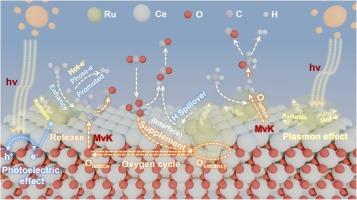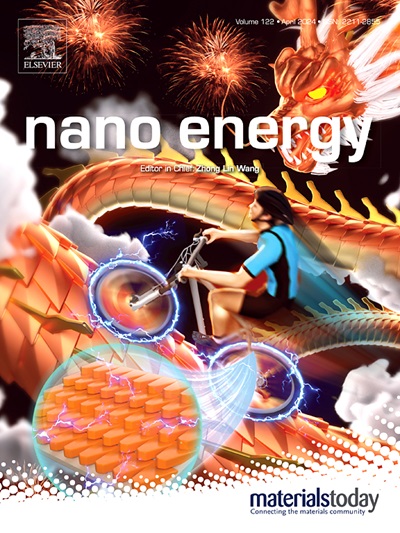强金属-支撑物相互作用诱导 Ru-Cluster-Ceria 催化剂光热催化甲烷干转化的优异性能
IF 16.8
1区 材料科学
Q1 CHEMISTRY, PHYSICAL
引用次数: 0
摘要
通过光热协同催化,利用太阳能驱动甲烷干重整(MDR)反应,可同时实现减少碳足迹和固定太阳能,是一条既环保又经济的途径。然而,目前开发的催化剂在催化性能和稳定性方面仍需进一步优化。在此,我们通过简便的制备方法制备了锚定在 CeO2 上的 Ru 纳米团簇催化剂 RuNC,该催化剂具有很强的金属-支撑相互作用(SMSI)效应。在 500 oC 的光热催化(PTC)条件下,RuNC 催化剂上的 H2 和 CO 生成率分别为 1.41 和 2.16 mol-gcat-1-h-1,比现有的 PTC-MDR 催化剂高出一个数量级。此外,所制备的催化剂在 100 小时试验中没有出现明显的失活现象。通过系统的结构表征,确定了催化活性/稳定性与 Ru 纳米团簇位点/诱导 SMSI 效应之间深入的结构-功能关系。通过光学表征证明了 RuNC 催化剂结构在 PTC 催化条件下的优势。此外,还通过 ISI-XPS 实验确定了 PTC 条件下光电子的激发-迁移路径。最后,通过操作实验确定了 PTC-MDR 反应机理以及光照射增强的特定反应步骤。这项工作为 PTC-MDR 路线的工业应用提供了理论依据和良好的催化剂。本文章由计算机程序翻译,如有差异,请以英文原文为准。

Strong metal-support interaction induced excellent performance for photo-thermal catalysis methane dry reforming over Ru-cluster-ceria catalyst
The utilization of solar energy in driving methane dry reforming (MDR) reaction through photo-thermal synergetic catalysis could simultaneously realize the reduction of carbon footprint and the fixation of solar energy, which is an environmentally and economically beneficial route. However, the currently developed catalysts still require further optimization in catalytic performance and stability. Here, we prepared RuNC, a Ru nanoclusters catalyst anchored on CeO2 with strong metal-support interaction (SMSI) effect via a facile preparation method. The formation rates of H2 and CO over RuNC catalyst were 1.41 and 2.16 mol·gcat−1·h−1 respectively under photo-thermal catalysis (PTC) at 500 °C, which is up to one order of magnitude higher than existing PTC-MDR catalysts. Moreover, the prepared catalyst did not show significant deactivation under 100 hour test. The in-depth structure-function relationship between catalytic activity/stability and Ru nanocluster sites/induced SMSI effect were determined by systematic structural characterization. The advantages of RuNC catalyst structure under PTC catalytic conditions were demonstrated by optical characterization. Besides, the excitation-migration path of photo-electron under PTC conditions was determined by ISI-XPS experiments. Finally, the mechanism of PTC-MDR reaction and the specific reaction steps enhanced by light irradiation were determined by operando experiments. This work provided theoretical basis and excellent catalyst for the industrial application of PTC-MDR route.
求助全文
通过发布文献求助,成功后即可免费获取论文全文。
去求助
来源期刊

Nano Energy
CHEMISTRY, PHYSICAL-NANOSCIENCE & NANOTECHNOLOGY
CiteScore
30.30
自引率
7.40%
发文量
1207
审稿时长
23 days
期刊介绍:
Nano Energy is a multidisciplinary, rapid-publication forum of original peer-reviewed contributions on the science and engineering of nanomaterials and nanodevices used in all forms of energy harvesting, conversion, storage, utilization and policy. Through its mixture of articles, reviews, communications, research news, and information on key developments, Nano Energy provides a comprehensive coverage of this exciting and dynamic field which joins nanoscience and nanotechnology with energy science. The journal is relevant to all those who are interested in nanomaterials solutions to the energy problem.
Nano Energy publishes original experimental and theoretical research on all aspects of energy-related research which utilizes nanomaterials and nanotechnology. Manuscripts of four types are considered: review articles which inform readers of the latest research and advances in energy science; rapid communications which feature exciting research breakthroughs in the field; full-length articles which report comprehensive research developments; and news and opinions which comment on topical issues or express views on the developments in related fields.
 求助内容:
求助内容: 应助结果提醒方式:
应助结果提醒方式:


